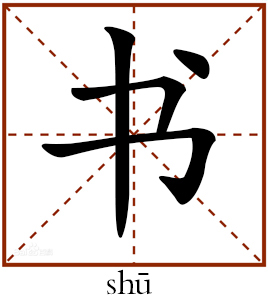Book

This character usually refers to a book, a document or a letter. As a verb, shu means to write.
临池学书 池水尽墨
lín chí xué shū chí shuǐ jìn mò
Lin means “close to” and chi refers to a pond. Xue means “to study.” Shui is “water.” Jin means “all” and mo is “ink.” “Lin chi”, meaning “close to the pond,” is a metaphor for practicing calligraphy.
This term originated from Si Ti Shu Shi (Dynamics of the Four Scripts), an important theoretical work on calligraphy created by Wei Heng (?–291) during the the West Jin Dynasty (265–316). “Zhang Boying (?–192, courtesy name of Han Zhang Zhi), who used to live in Hongnong Country, mastered the most ingenious brush-turning technique. Every piece of cloth in his house would first be used as paper for calligraphy practise before being dye and turned into clothes. Zhang practiced calligraphy by a pond and used the water to wash his brush. As time went by, the water turned inky because he was so diligent.”
Zhang Zhi was a pioneer of the modern cursive script, and was honored as the “Sage of Cursive Script” and one of the Four Talented Calligraphers in Chinese calligraphy, the other three being Zhong Yao (151–230), Wang Xizhi (303–361) and his son Wang Xianzhi (344–386). Sadly, despite the great fame Zhang enjoyed in ancient times, no verifiable works of his have survived.
Admiring Zhang Zhi, Wang Xizhi followed his example by washing his brush and ink stone in the pond in front of his house after practicing each day. The pond turned darker day by day, and later gained the name “Wang Xizhi’s Ink Pond.”
edited by WENG RONG
